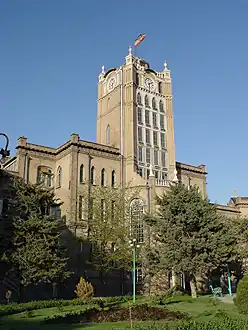Saheb-ol-Amr Mosque
| Sāheb ol Amr Mosque | |
|---|---|
 The mosque in 2017 | |
| Religion | |
| Affiliation | Shia Islam |
| Ecclesiastical or organisational status | Mosque |
| Status | Active |
| Location | |
| Location | Tabriz, Tabriz County, East Azerbaijan |
| Country | Iran |
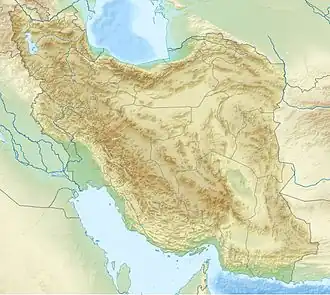 Location of the mosque in Iran | |
| Geographic coordinates | 38°05′03″N 46°17′45″E / 38.0841°N 46.2957°E |
| Architecture | |
| Type | Mosque architecture |
| Style | Safavid |
| Founder | Tahmasp I |
| Completed |
|
| Destroyed | 1638[a] (by Murad IV) |
| Specifications | |
| Dome(s) | One (maybe more) |
| Minaret(s) | Two |
| Materials | Bricks |
| Official name | Sāheb ol Amr Mosque |
| Type | Built |
| Designated | 2 October 2001 |
| Reference no. | 4196 |
| Conservation organization | Cultural Heritage, Handicrafts and Tourism Organization of Iran |
| [1] | |
The Sāheb ol Amr Mosque (Persian: مسجد صاحب الامر, romanized: Masjid-e Sāheb ol Amr; Arabic: مسجد صاحب الأمر), also known as the Shah Tahmasp Mosque,[2] is a Shi'ite mosque, located on the east side of Saaheb Aabaad square in Tabriz, East Azerbaijan province, Iran. The mosque was rebuilt in 1636 CE and has a history of destruction and repair. The name Sāheb ol Amr (Master of command) is one of the titles of the last Twelver Shī‘ah Imām.[3]
The mosque was added to the Iran National Heritage List on 2 October 2001, administered by the Cultural Heritage, Handicrafts and Tourism Organization of Iran.
History
The mosque is said to have been built by the Safavid shah Tahmasp I (r.1524-1576), and that it was the first mosque of his reign. The mosque is sometimes known as the Shah Tahmasb Mosque.[4]
Not long after its construction, the building was destroyed by the Ottoman ruler Murad IV after he invaded Tabriz in 1638. Once Iranian troops re-affirmed control over the city, the mosque was rebuilt but suffered great damage from an earthquake that struck the city soon after. Consequently, the entire square along with the mosque was reconstructed and this task was carried out by Goli Khan Danbali.[1] In favour of the people, the mosque was dubbed Sāheb ol Amr, a title of the last Twelver Shī‘ah Imām, Muhammad al-Mahdi.[3] In the 1673 map of Tabriz by Jean Chardin, the mosque appears under the name Saheb Saman and the explanation "Mosque of the last true Calif".[5]
The school yard was destroyed during the expansion of Daraiee Street by the city of Tabriz and only a part of school is now retained.
In ancient times, the Temple of Mithraism was located on this site. The building currently houses a mosque and a Quran museum.[1] The mosque underwent extensive restoration during the 1990s.[4]
Gallery
-
![Saheb Saman Mosque (E on the map), by Jean Chardin (1673).[2]](./_assets_/Saheb_Saman_Mosque_(E)._Tabriz._Voyages_de_Jean_Chardin_(1673).jpg) Saheb Saman Mosque (E on the map), by Jean Chardin (1673).[2]
Saheb Saman Mosque (E on the map), by Jean Chardin (1673).[2] -
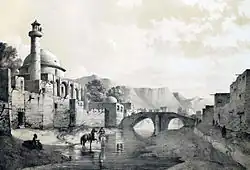 luustration by Eugène Flandin, 1840
luustration by Eugène Flandin, 1840 -
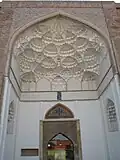 Entrance Iwan
Entrance Iwan -
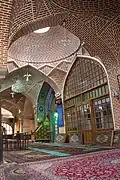 Interior view
Interior view -
The mosque at night
-
View from the street
-
The mosque at night
See also
- Shia Islam in Iran
- List of mosques in Iran
- Haidarzadeh House
- House of Seghat-ol-Eslam
- Madrasah Akbarieh
Notes
- ^ Since rebuilt
References
- ^ a b c "Saheb-ol Amr Mosque and Museum". Iran Tourist and Touring Organization. 2025. Retrieved March 17, 2025.
- ^ a b Sarabi, Mina (May 10, 2023). "Architectural and Spatial Design studies of Sahibabad, Tabriz, Iran in the Persian Miniature Painting "Nighttime in a Palace"". JACO Quarterly: 72, Fig.9, item 4. doi:10.22034/JACO.2022.366374.1270.
- ^ a b A Brief History of The Fourteen Infallibles. Qum: Ansariyan Publications. 2004. p. 159.
- ^ a b "Saheb-ol-Amr Mosque". Islamic Cultural Heritage. 2019. Retrieved March 17, 2025.
- ^ Chardin, Jean (1643-1713) Auteur du texte; Charpentier, François (1620-1702) Auteur du texte (1686). Journal du voyage du chevalier Chardin en Perse & aux Indes Orientales , par la Mer Noire & la Colchide... (in French). p. Map of Tauris (Tabriz), label E.
{{cite book}}: CS1 maint: numeric names: authors list (link)
External links
- "Virtual Museum of Historical Buildings of Tabriz". School of Architecture. Tabriz Islamic Art University. Archived from the original on March 8, 2009.
- دانشگاه هنر اسلامی تبریز (in Persian). Tabriz, Iran: Tabriz Islamic Art University. Archived from the original on April 18, 2009.
- دانشگاه هنر اسلامی تبریز (in Persian). Tabriz, Iran: Tabriz Islamic Art University. Archived from the original (Picture gallery) on May 16, 2007.
- "Home page". Iranian Student's Tourism & Traveling Agency. Archived from the original on August 18, 2008. (also in Persian Archived August 25, 2008, at the Wayback Machine.)
- "Tabriz virtual gallery". Tabrizian.ac.ir. Archived from the original on September 27, 2007.
- "Home". eachto.ir.
